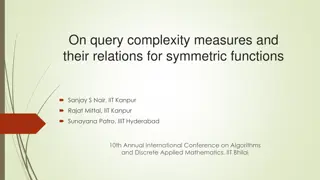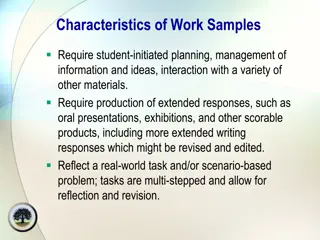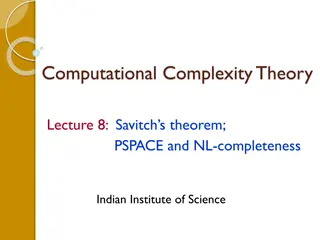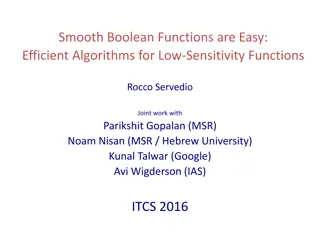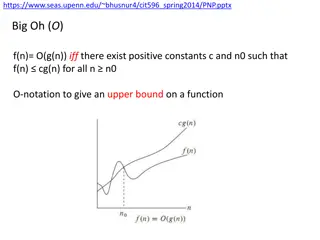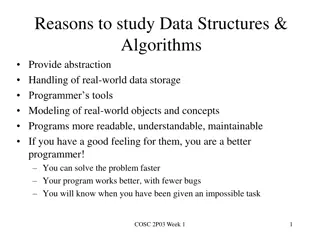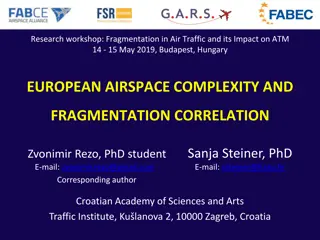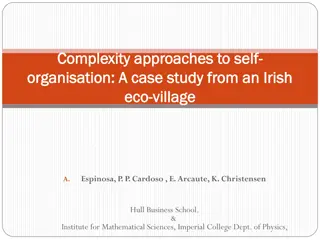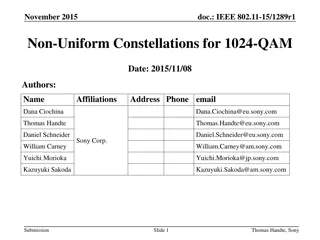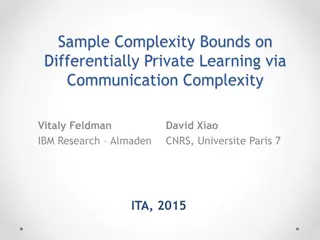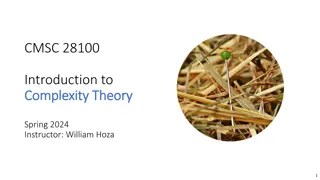Information Management and Technology Complexity
Information management in the realm of technology complexity and computational scaling plays a crucial role in modern society. Understanding the intricacies of data handling and system complexities is essential for organizations and individuals alike. Explore the theories, challenges, and significance of information science in today's digital age.
Download Presentation

Please find below an Image/Link to download the presentation.
The content on the website is provided AS IS for your information and personal use only. It may not be sold, licensed, or shared on other websites without obtaining consent from the author.If you encounter any issues during the download, it is possible that the publisher has removed the file from their server.
You are allowed to download the files provided on this website for personal or commercial use, subject to the condition that they are used lawfully. All files are the property of their respective owners.
The content on the website is provided AS IS for your information and personal use only. It may not be sold, licensed, or shared on other websites without obtaining consent from the author.
E N D
Presentation Transcript
IST 511 Information Management: Information and Technology Complexity, complex systems, computational complexity and scaling Dr. C. Lee Giles David Reese Professor, College of Information Sciences and Technology Professor of Computer Science and Engineering Professor of Supply Chain and Information Systems The Pennsylvania State University, University Park, PA, USA giles@ist.psu.edu http://clgiles.ist.psu.edu Thanks to Peter Andras, Costas Busch
Last time What is information Information Informatics information science information theory Information in all aspects of science and society What is defined often depends on the domain How much information is there? Giga, tera, peta, exa, zetta When did it happen Where is it going
Today What is complexity Complex systems Measuring complexity Computational complexity Big O Scaling Why do we care Scaling is often what determines if information technology works Scaling basically means systems can handle a great deal of Inputs Users Methodology scientific method
Tomorrow Topics used in IST Representation AI Machine learning Information retrieval and search Text Encryption Social networks Probabilistic reasoning Digital libraries Others?
Theories in Information Sciences Enumerate some of these theories in this course. Issues: Unified theory? Domain of applicability Conflicts Theories here are mostly algorithmic Quality of theories Occam s razor Subsumption of other theories
What we know Complex systems are everywhere More and more information/data born digital Tera and exa and petabytes of stuff Information management is important Companies, governments, organizations, individuals spend significant resources managing information/data and complex systems
What is complexity ? The buzz word complexity : complexity of a trust (Guardian, February 12, 2002) increasing complexity in natural resource management (Conservation Ecology, January 2002) citizens add an additional level of complexity (Political Behavior, March 2001)
Complex micro-worlds gene interaction system; protein interaction system; The system of functional protein interaction clusters in the yeast (www.cellzome.com). protein structure;
Complex organisms C. Elegans (devbio-mac1.ucsf.edu) complex cell patterns; complex organs; complex behaviours; C. Elegans ventral ganglion transverse- section (www.wormbase.org)
Complex machines apxhgfldj.jpg (22950 )
Complexity for information science Why complexity? Modeling & prediction of behavior of a complext system Also for evaluating difficulty in scaling up a problem How will the problem grow as resources increase? Information retrieval search engines often have to scale! Knowing if a claimed solution to a problem is optimal (best) Optimal (best) in what sense?
Complex systems A complex system is a system composed of interconnected parts that as a whole exhibit one or more properties (behavior among the possible properties) not obvious from the properties of the individual parts. A system s complexity may be of one of two forms: disorganized complexity and organized complexity. In essence, disorganized complexity is a matter of a very large number of parts, organized complexity is a matter of the subject system (quite possibly with only a limited number of parts) exhibiting emergent properties. From Wikipedia
Features of complex systems Difficult to determine boundaries It can be difficult to determine the boundaries of a complex system. The decision is ultimately made by the observer (modeler). Complex systems may be open Complex systems are usually open systems that is, they exist in a thermodynamic gradient and dissipate energy. In other words, complex systems are frequently far from energetic equilibrium: but despite this flux, there may be pattern stability. Complex systems may have a memory (often called state) The history of a complex system may be important. Because complex systems are dynamical systems they change over time, and prior states may have an influence on present states. More formally, complex systems often exhibit hysteresis. Complex systems may be nested The components of a complex system may themselves be complex systems. For example, an economy is made up of organizations, which are made up of people, which are made up of cells - all of which are complex systems.
Features of complex systems Dynamic network of multiplicity As well as coupling rules, the dynamic network of a complex system is important. Small-world or scale-free networks which have many local interactions and a smaller number of inter-area connections are often employed. Natural complex systems often exhibit such topologies. In the human cortex for example, we see dense local connectivity and a few very long axon projections between regions inside the cortex and to other brain regions. May produce emergent phenomena Complex systems may exhibit behaviors that are emergent, which is to say that while the results may be sufficiently determined by the activity of the systems' basic constituents, they may have properties that can only be studied at a higher level. For example, the termites in a mound have physiology, biochemistry and biological development that are at one level of analysis, but their social behavior and mound building is a property that emerges from the collection of termites and needs to be analyzed at a different level.
Features of complex systems Relationships are nonlinear In practical terms, this means a small perturbation may cause a large effect (see butterfly effect), a proportional effect, or even no effect at all. In linear systems, effect is always directly proportional to cause. Relationships contain feedback loops Both negative (damping) and positive (amplifying) feedback are always found in complex systems. The effects of an element's behaviour are fed back to in such a way that the element itself is altered.
Examples of complex systems From complexity to simplicity Big history: how the universe creates complexity
Complexity for information science Complex systems University of Michigan Center for Complex Systems Models of complexity Computational (algorithmic) complexity Information complexity System complexity Physical complexity Others?
Why do we have to deal with this? Moore s law Growth of information and information resources Management Storage Search Access Privacy Modeling
Types of Complexity Computational (algorithmic) complexity Information complexity System complexity Physical complexity Others?
Impact The efficiency of algorithms/methods The inherent "difficulty" of problems of practical and/or theoretical importance A major discovery in the science was that computational problems can vary tremendously in the effort required to solve them precisely. The technical term for a hard problem is "NP-complete" which essentially means: "abandon all hope of finding an efficient algorithm for the exact (and sometimes approximate) solution of this problem". Liars vs damn liars
Optimality A solution to a problem is sometimes stated as optimal Optimal in what sense? Empirically? Theoretically? (the only real definition) Cause we thought it to be so? Different from best
We will use algorithms An algorithm is a recipe, method, or technique for doing something. The essential feature of an algorithm is that it is made up of a finite set of rules or operations that are unambiguous and simple to follow (i.e., these two properties: definite and effective, respectively).
Which algorithm to use? You have a friend arriving at the airport, and your friend needs to get from the airport to your house. Here are four different algorithms that you might give your friend for getting to your home: The taxi algorithm: Go to the taxi stand. Get in a taxi. Give the driver my address. The call-me algorithm: When your plane arrives, call my cell phone. Meet me outside baggage claim. The rent-a-car algorithm: Take the shuttle to the rental car place. Rent a car. Follow the directions to get to my house. The bus algorithm: Outside baggage claim, catch bus number 70. Transfer to bus 14 on Main Street. Get off on Elm street. Walk two blocks north to my house.
Which algorithm to use? An algorithm for solving a problem is not unique. Which should we use? Based on cost Number of inputs Number of outputs Time (time vs space) Likely to succeed etc Most solutions often based on similar problems
Good source of definitions http://www.nist.gov/dads/
Scenarios I ve got two algorithms that accomplish the same task Which is better? I want to store some data How do my storage needs scale as more data is stored Given an algorithm, can I determine how long it will take to run? Input is unknown Don t want to trace all possible paths of execution For different input, can I determine how an algorithm s runtime changes?
Measuring the Growth of Work or Hardness of a Problem While it is possible to measure the work done by an algorithm for a given set of input, we need a way to: Measure the rate of growth of an algorithm based upon the size of the input (or output) Compare algorithms to determine which is better for the situation Compare and analyze for large problems Examples of large problems?
Time vs. Space Very often, we can trade space for time: For example: maintain a collection of students with ID information. Use an array of a billion elements and have immediate access (better time) Use an array of number of students and have to search (better space)
Introducing Big O Notation Will allow us to evaluate algorithms. Has precise mathematical definition Used in a sense to put algorithms into families Worst case scenario What does this mean? Other types of cases?
Why Use Big-O Notation Used when we only know the asymptotic upper bound. What does asymptotic mean? What does upper bound mean? If you are not guaranteed certain input, then it is a valid upper bound that even the worst-case input will be below. Why worst-case? May often be determined by inspection of an algorithm.
Size of Input (measure of work) In analyzing rate of growth based upon size of input, we ll use a variable Why? For each factor in the size, use a new variable n is most common Examples: A linked list of n elements A 2D array of n x m elements A Binary Search Tree of p elements
Formal Definition of Big-O For a given function g(n), O(g(n)) is defined to be the set of functions O(g(n)) = {f(n) : there exist positive constants c and n0 such that 0 f(n) cg(n) for all n n0}
Visual O( ) Meaning cg(n) Upper Bound f(n) f(n) = O(g(n)) Work done Our Algorithm n0 Size of input
Simplifying O( ) Answers We say Big O complexity of 3n2 + 2 = O(n2) drop constants! because we can show that there is a n0 and a c such that: 0 3n2 + 2 cn2 for n n0 i.e. c = 4 and n0 = 2 yields: 0 3n2 + 2 4n2 for n 2 What does this mean?
Simplifying O( ) Answers We say Big O complexity of 3n2 + 2n = O(n2) + O(n) = O(n2) drop smaller!
Correct but Meaningless You could say 3n2 + 2 = O(n6) or 3n2 + 2 = O(n7) But this is like answering: What s the world record for the mile? Less than 3 days. How long does it take to drive to Chicago? Less than 11 years.
Comparing Algorithms Now that we know the formal definition of O( ) notation (and what it means) If we can determine the O( ) of algorithms This establishes the worst they perform. Thus now we can compare them and see which has the better performance.
Comparing Factors N2 N Work done log N 1 Size of input
Correctly Interpreting O( ) O(1) or Order One Does not mean that it takes only one operation Does mean that the work doesn t change as n changes Is notation for constant work O(n) or Order n Does not mean that it takes n operations Does mean that the work changes in a way that is proportional to n Is a notation for work grows at a linear rate
Complex/Combined Factors Algorithms typically consist of a sequence of logical steps/sections We need a way to analyze these more complex algorithms It s easy analyze the sections and then combine them!
Example: Insert in a Sorted Linked List Insert an element into an ordered list Find the right location Do the steps to create the node and add it to the list 17 38 head // 142 Step 1: find the location = O(N) Inserting 75
Example: Insert in a Sorted Linked List Insert an element into an ordered list Find the right location Do the steps to create the node and add it to the list 17 38 head // 142 75 Step 2: Do the node insertion = O(1)
Combine the Analysis Find the right location = O(n) Insert Node = O(1) O(n) Sequential, so add: O(n) + O(1) = O(n + 1) = Only keep dominant factor
Example: Search a 2D Array Search an unsorted 2D array (row, then column) Traverse all rows For each row, examine all the cells (changing columns) 1 2 3 4 5 1 2 3 4 5 6 7 8 9 10 O(N) Row Column
Example: Search a 2D Array Search an unsorted 2D array (row, then column) Traverse all rows For each row, examine all the cells (changing columns) 1 2 3 4 5 1 2 3 4 5 6 7 8 9 10 Row Column O(M)
Combine the Analysis Traverse rows = O(N) Examine all cells in row = O(M) Embedded, so multiply: O(N) x O(M) = O(N*M)
Sequential Steps If steps appear sequentially (one after another), then add their respective O(). N loop . . . endloop loop . . . endloop O(N + M) M




